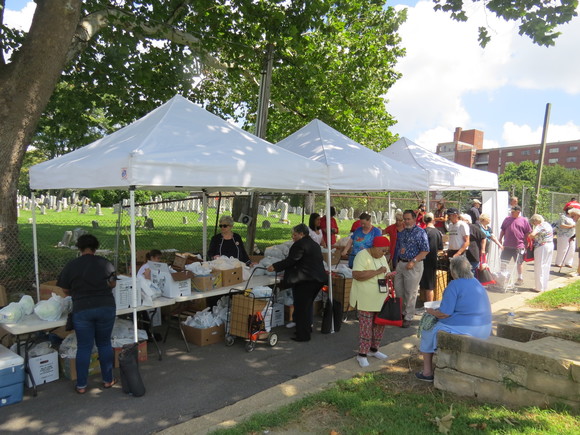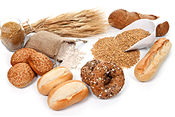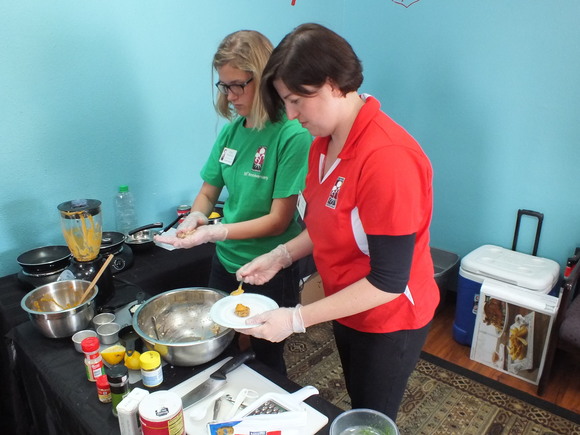
Maryland CSFP Kick-off Event
On August 12th,
the Maryland Department of Aging, held its Commodity Supplemental Food Program (CSFP)
kick-off event at St. Mary’s Outreach Center in Baltimore. As of 2015, Maryland is a new CSFP state. The Food
Distribution staff from the Mid-Atlantic Regional Office was there to offer
support and join in on the celebration. Renamed My Groceries to Go! by
the State, this program provides seniors with a wide variety of food to
supplement their diets. Representatives from the State’s Department of Aging,
Maryland Food Bank, St. Mary’s Outreach Center, and USDA talked about the
benefits of the program and the nutritional value this food package provides to
its participants.
While CSFP was the main
focus of the event, participants had many other reasons to smile. Staff from
the Maryland Food Bank brought a truckload of fresh produce to distribute.
Outside, volunteers from the food bank and Maryland Department of Aging helped
participants make selections from boxes filled with cabbage, corn, tomatoes,
and cucumbers. On the inside, a chef from the Cooking with Heart Kitchen of
Baltimore prepared a chicken stir fry dish for seniors to sample, showing how
to incorporate the fresh vegetables they just received into a healthy,
nutritious, and tasty dish. Recipes for the stir fry and other dishes that use
items from the CSFP food package were given to all attendees. Several tables
were set up by local agencies offering additional information to help seniors
with limited resources.
The event was well
received by Baltimore seniors. They were happy that CSFP is now being offered
in their community and look forward to receiving their food package each month.
Through hard work, dedication, and strong Maryland partnerships My Groceries to Go! will grow throughout
the State.
Congratulations Maryland
Department of Aging and Maryland Food Bank for hosting a great event!
|


Several Apple Varieties Are Now Available to
TEFAP
Autumn is quickly approaching, which means it's apple season!
Whether you're bobbing for them, putting them on your favorite teachers desk,
or eating one a day, to keep the doctor away, apples are some of the
most versatile fruit you can have.
In FY 2015, to date, USDA has purchased about 30 million pounds
of apples for distribution through TEFAP. The recent market support purchase
for apples provided a combination of fresh apples and processed apple products.
A portion of the purchase offered apple juice, canned applesauce and applesauce
cups. The other portion offered fresh apple choices in many varieties including
Delicious, Red Delicious, Rome Beauty, Empire, Jonagold, Gala, Fuji, Braeburn
and Granny Smith.
For more information on how to use your apples visit: USDA Foods Fact Sheet or the National
Agricultural Library’s Apple Information Page.
|
 Temperature is one of the most important factors in maintaining quality and safety of USDA Foods. Grain products, including rice, flour, and pasta, should be stored in a cool dry place. Ideal temperature is 50°F with relative humidity between 50-70%. We recommend that grain products be stored under refrigeration, if possible.
Grains such as rice, flour, and pasta products are susceptible to insect infestation when not stored under proper temperature and/or stored for extended periods of time. The most effective way to avoid deterioration of product quality (particularly grain products) is to use the product within the appropriate time frame. Distribution Agencies should only order product quantities that can be distributed in enough time for the program participants to use the product while at peak quality.
Products must be stored properly and used in a timely manner for USDA to consider product replacement when States report quality complaints. Brown rice has unique storage requirements and warranty timeframes. Rice should be stored off the floor in a cool, dry, well-ventilated place with an ideal temperature of 50°F and relative humidity between 50 and 70%. If ideal storage conditions are not available, rice can be stored under refrigeration. When stored at room temperature, brown rice should be distributed and used within 3 months. When stored under refrigeration, brown rice should be distributed and used within 6 months.
|
Partnering with Faith-Based and Community Organizations
to Better Serve People in Need
At USDA we work through partnerships to provide opportunities to
people in need. Through relationships with both faith-based and secular
community organizations, we are able to achieve our shared goals representative
of America’s core values of caring for each other, including making sure that
every family and every child is healthy and hunger free. Our partners
serve thousands of Americans each day, providing emergency food assistance to
families and nutritious meals to kids in the summer when school is closed.
Partnerships with community organizations are critical; fidelity
to constitutional principles is equally important. So we have
worked to develop regulations that will ensure that we can continue to partner
with faith-based organizations in the delivery of USDA-supported services,
while ensuring that the religious liberty of those organizations as well as
families and taxpayers is respected. Read More
 New Nutrition Education Resource for Seniors: Choosing Healthy Meals as You Get Older
Making healthy food choices is a smart thing to do-no matter how old you are! Your body changes through your 60s, 70s, 80s, and beyond. Food provides nutrients you need as you age. Use these tips to choose foods for better health at each stage of life. Read more
Please note that, as with all foods, anyone who needs a special diet to treat health concerns should follow the diet recommended by his or her physician.
|
 The Importance of Destination Information
USDA contracts with vendors to deliver the foods offered through WBSCM. Purchase orders placed online constitute part of the contractual agreement with these vendors. After a purchase order is awarded, unanticipated changes to the destination address or contact information initiate a process of contract modification, which consumes considerable time and administrative resources for everyone involved.
Understandably, some changes cannot be foreseen or executed before a contract is awarded. To allow sufficient time to make and communicate modifications, the following are recommended best practices for States (SDAs) and Recipient Agencies (RAs), if applicable:
- Review orders in process to ensure the correct destination is identified.
- Communicate destination changes at least 45 days prior to the start of the delivery period. For example, destinations changes for the October 16 – 30 delivery window should be received by September 1.
In the event a SDA needs to add a new destination or modify the existing contact information, FNS has set up a central e-mail address for updates to Ship-to information: WBSCM-Ship-To@fns.usda.gov. Please note this address is for management of the master list of destinations and not for changes to destinations on orders.
For more information about USDA’s contract award dates for each calendar year, States are invited to review documentation published on the AMS Commodity Purchasing website: http://www.ams.usda.gov/AMSv1.0/commoditypurchasing. Solicitations are generally issued 30 days in advance of the anticipated award date or about 90 days prior to the start of the delivery period.
|

FNS Staff Visit San Antonio Food Bank and
local CSFP site
FNS
staff visited one of the largest urban farms in San Antonio, at the San Antonio Food Bank. The San Antonio Food Bank is a Texas Department
of Agriculture and USDA partner organization that operates a number of federal
programs, including CSFP and TEFAP. FNS staff were excited to tour the innovative
project, whose purpose is to provide needy families with freshly grown produce as
well as to teach health and wellness and educate the community on how to
grow their own crops.
Last year the San Antonio Food Bank harvested
approximately 150,000 pounds of produce, fruits and herbs from its farm.
This year they plan on harvesting a little over 200,000 pounds. The fresh
produce is distributed in their soup kitchens, through mobile pantries,
at food fairs, and at other Food Bank sites. The Food Bank farm also focuses on green energy,
renewable resources, and organic practices in its operations and houses three
bee stations on site for cross pollination.
For more information on nutrition assistance programs in Texas, please visit the Texas Department of Agriculture website: www.squaremeals.org.
While in the area, FNS staff also visited a CSFP distribution at the District 5 Senior Center, which partners with the San Antonio Food Bank and the City of San Antonio to bring food, nutrition, and wellness services to the local senior population. The San Antonio Food Bank offers three programs through the District 5 program: CSFP, Project HOPE, (a monthly grocery program for seniors), and the Senior Farmers' Market Nutrition Program.
Currently, Ben Dominguez runs the nutrition program and oversees the CSFP, Project HOPE and SFMNP programs at District 5. He serves approximately 90 seniors a month with CSFP alone. District 5 also offers a variety of other activities for seniors ranging from dance classes and "garage sales," to nutrition and computer skills classes.
|
 (Top) FNS staff touring the San Antonio Food Bank’s farm. (Bottom) Individuals from left to right at District 5 Senior Center: Matt McElhaney, site Volunteer, Mike Calvillo, Erica Antonson, Katy Foster, Emily Larsen, Ben Dominguez.

Welcome to Subtropolis: Tour of the Paris
Brothers Cave Warehouse
What do you do with an over 500,000 square foot limestone
underground cave? Well store food, of course-and that is exactly what the Paris
Brothers did in 1983, when they opened the Paris Brother’s Cave Warehouse. The
“caves” were created as the limestone was being mined, and by design, the
miners left support columns throughout the mine anticipating commercial
development.
FNS staff had the opportunity to visit “Subtropolis” in Kansas
City, Missouri and tour one of USDA’s contracted national warehouses. The Paris Brothers
Warehouse services both FDPIR and CSFP multi-food deliveries for particular
States. Steve Wolfe and Anthony Paris provided a tour of the cave which is
the perfect climate for dry storage, cooler and freezer space and distributes
over 4,500 items to grocers, food distributers and warehouses.
The caves maintain a constant temperature of about 68°F, perfect
for storing a wide variety of products, and there are roads that support
trailer-truck traffic and railroad tracks for train deliveries. In
addition to the Paris Brothers Inc. Warehouse, the caves are home to a number
of other businesses that, combined, employ over 1,000 people.
Thanks again, to Steve and Anthony for being such great hosts.
|

 Salmon Cakes: Idaho Makes the Most Out of Their CSFP Food Package
Ingredients
Vegetable oil or
cooking spray
1 can salmon,
undrained, with bones
1 1/2 cups rice cereal
1/4 cup finely chopped
onion
2 Tablespoons light
mayonnaise
2 Teaspoons lemon
juice
Any spices you have at
home such as garlic, dill, parsley, paprika, or chili powder
Salt and pepper to
taste
Directions
1. Mix all the
ingredients together in a large bowl.
2. Form small
patties, about 2 inches across and 1/2 inch thick.
3. Add cooking
spray or about 2 tablespoons of oil to a medium saucepan. Heat up the pan to
medium-high.
4. Cook the
patties for about 3 minutes on each side. Place on a baking sheet in an oven
preheated to 375⁰F and bake for 15-20
minutes.
Substitutions
1 large or 1/4 cup of liquid eggs can be substituted
for light mayonnaise; Rice cereal can be substituted for corn flake cereal.
Serving size: 1 patty; Calories: 205 ; Fat 6 g; Saturated Fat: 1g; Sodium: 529mg; Total Carbohydrate: 11g; Dietary Fiber: 0 g; Protein: 26 g; Calcium: 19mg; Iron: 4mg; B12: 3.7µg
|
 (Top) The completed salmon patty. A great source of protein and healthy fats.(Bottom) The Idaho Food bank’s Nutrition Education staff created this salmon patty using some of the ingredients in May’s CSFP food package.

Fiscal Year (FY) 2016 Appropriations Update
We are in the final quarter of Fiscal Year (FY) 2015 and
have started to look toward FY 2016, including watching to see how much funding
will be provided to CSFP and TEFAP in the coming fiscal year. The President’s
Budget Request for FY 2016, published early this year, proposed
$221.298 million for CSFP. This amount would support a small caseload
increase of 10,000 slots, which would bring the total caseload to 614,000 slots
nationwide in 2016. For TEFAP, the President’s Budget proposed a total of
$369.151 million, including $319.75 million for food purchases and $49.4
million for administrative funding. The President’s Budget is just the
first step in the federal funding process. Congress has the final say on
funding, so we won’t know how much money is available for the programs until
the House of Representatives and the Senate pass Agriculture
Appropriations legislation for FY2016 and the President signs the
legislation into law.
The House and Senate Appropriations Committees both approved
initial bills in July, but neither Chamber has voted on a final bill. The
House version matches the President’s Budget requests for CSFP and TEFAP.
The Senate bill matches the President’s Budget request for CSFP and provides an
additional $4.25 million for TEFAP food purchases. It remains to be seen
what funding level Congress will ultimately provide.
|
CSFP Distribution Site in the 1980's, hands out free samples of the winning Recipe of the Month.
|